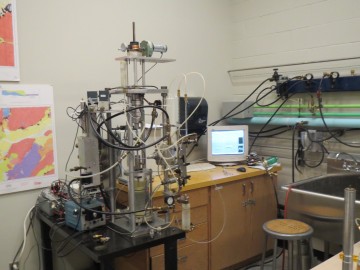
 The triaxial apparatus permits axisymmetric states in compression and extension loading. Cylindrical specimens, with a height:diameter ratio of at least 2:1, are subjected to asymmetric loading in this test. Only compression tests where the major principle stress acts vertically and extension tests with major principle stress acting horizontally can be simulated with the static/cyclic triaxial device.
The triaxial apparatus permits axisymmetric states in compression and extension loading. Cylindrical specimens, with a height:diameter ratio of at least 2:1, are subjected to asymmetric loading in this test. Only compression tests where the major principle stress acts vertically and extension tests with major principle stress acting horizontally can be simulated with the static/cyclic triaxial device.
The major and minor principle stress magnitudes can be controlled. The intermediate principle stress equals either the minor principle stress in a compression test, or the major principle stress in an extension test.
Several triaxial systems are presently available for research work. Extensive research work that has been carried out using these devices include:
- stress/strain path testing of cohesive and non-cohesive soils
- effect ageing and drainage on the response of sand
- liquefaction of soils under cyclic loading.
Specimen Sizes:
Maximum Diameter = 63 mm, Height = 130 mm
Maximum Diameter = 73 mm, Height = 150 mm
Stress-Strain Application:
Vertical stress is applied by a double acting piston connected to an Electro-Pneumatic regulator which is controlled by a computer. Confining stress is derived from pressurized air controlled by regulators. Axial strain is produced by a motor drive system.
Loading Modes:
- Isotropic and K0 consolidation
- Monotonic triaxial compression and triaxial extension
- Cyclic shear.
- Data acquisition using "National Institutional AT-MIO16x, 16-bit high-speed data acquisition card"
- 8 Analog to Digital input channels:5 A/D channels for transducers: Load cell, LVDT, Pressure Transducer (2), DPT
- 2 Digital to Analog output channels:One D/A channel controls the Electro-Pneumatic Pressure Regulator
- One D/A channel controls the Motor Drive
- DAQ is capable of gathering 3000 data sets per second.
- Gathered data is averaged over 60 readings to reduce electrical noise.
- Signal conditioning is done before feeding the signals into A/D cards.
| Transducer | Measurement/Control | Resolution |
| Load Cell | Deviator Stress | 0.04 kPa |
| Pressure Transducer (1) | Confining Stress | 0.25 kPa |
| Pressure Transducer (1) | Pore Pressure | 0.25 kPa |
| LVDT | Vertical Strain | 0.001% |
| DPT | Volumetric Strain | 0.001% |
| Electro-Pneumatic Pressure Regulator | Apply and Control Shear Stress | 0.1 kPa |
